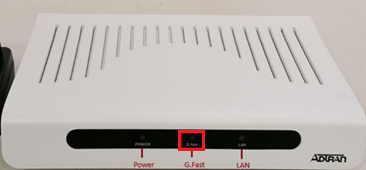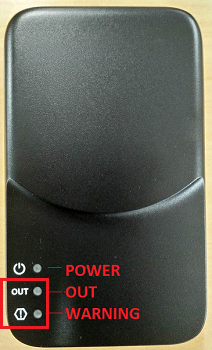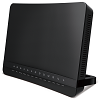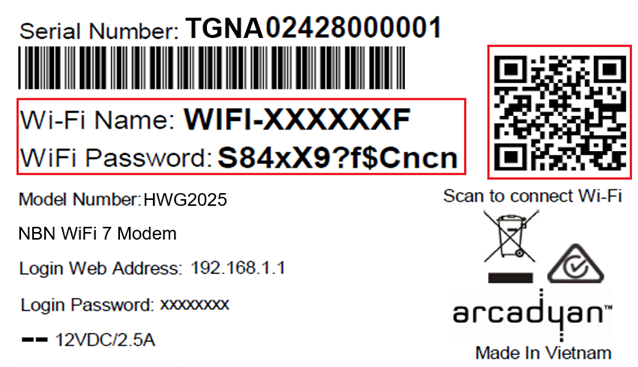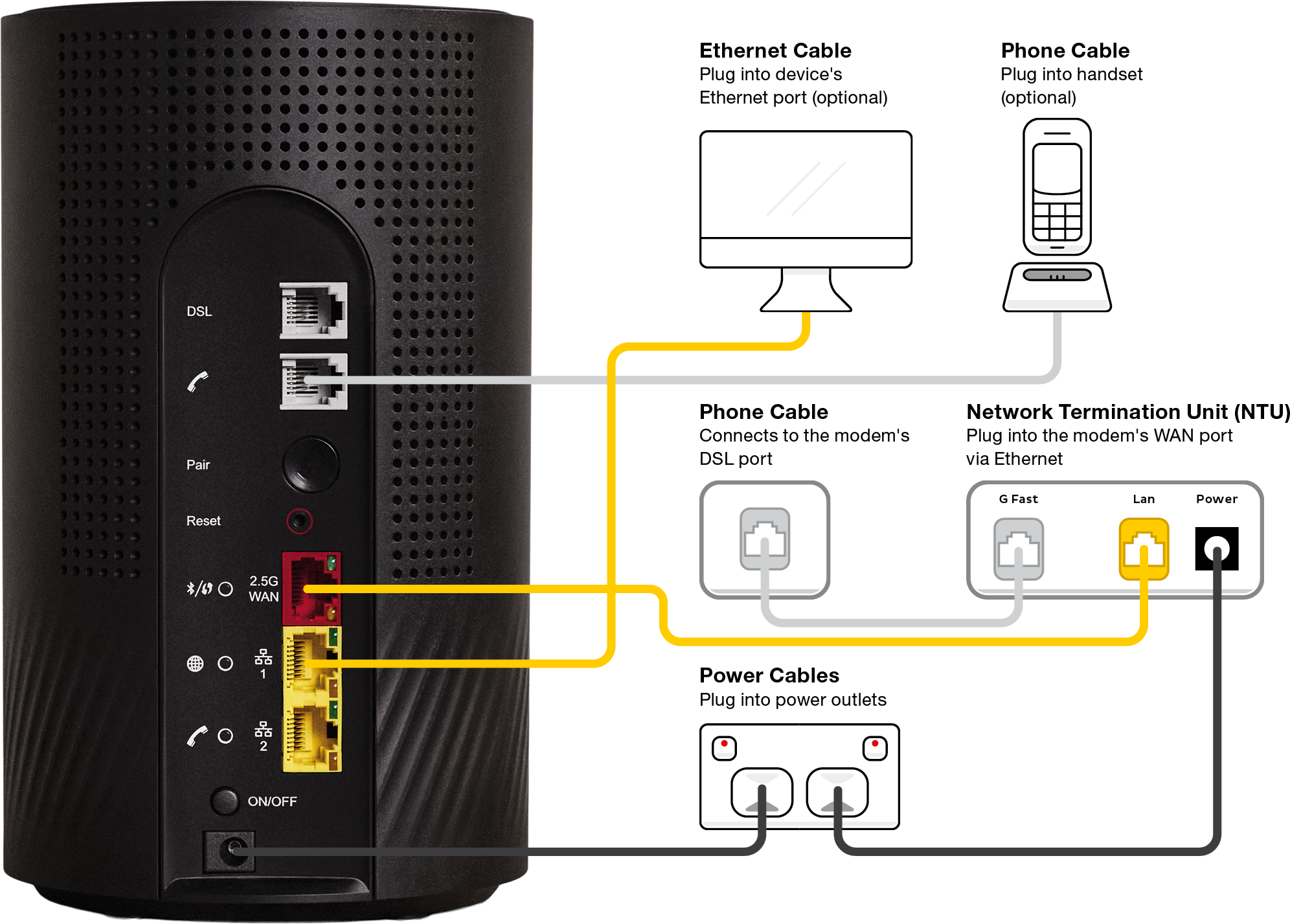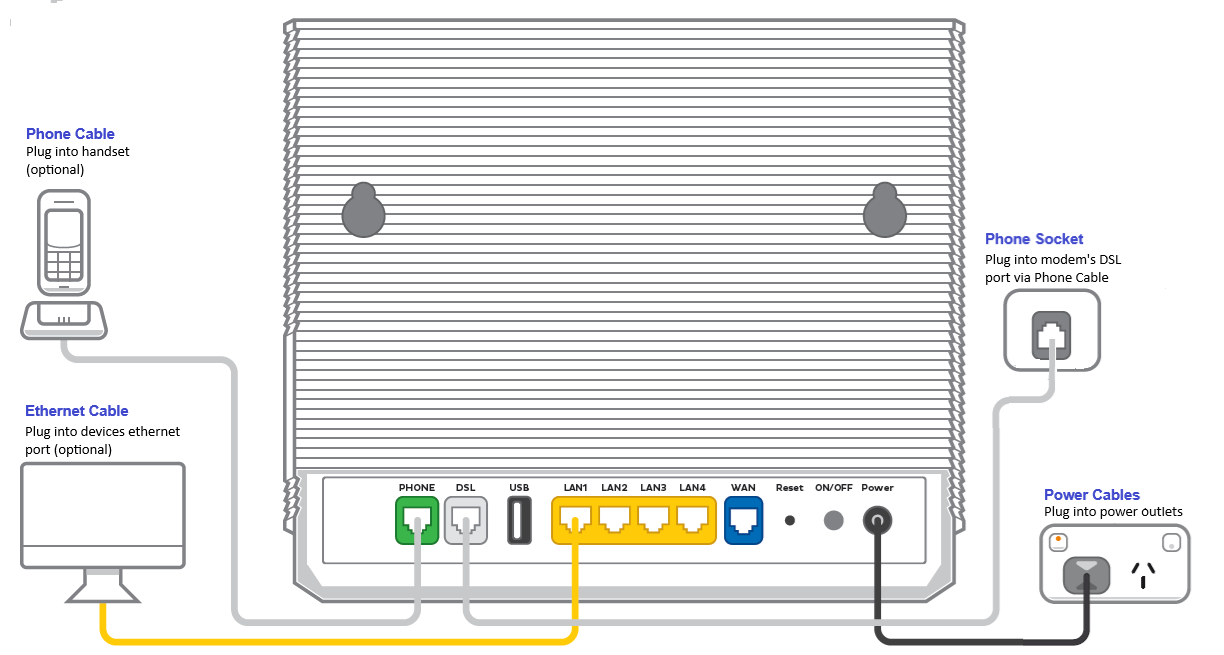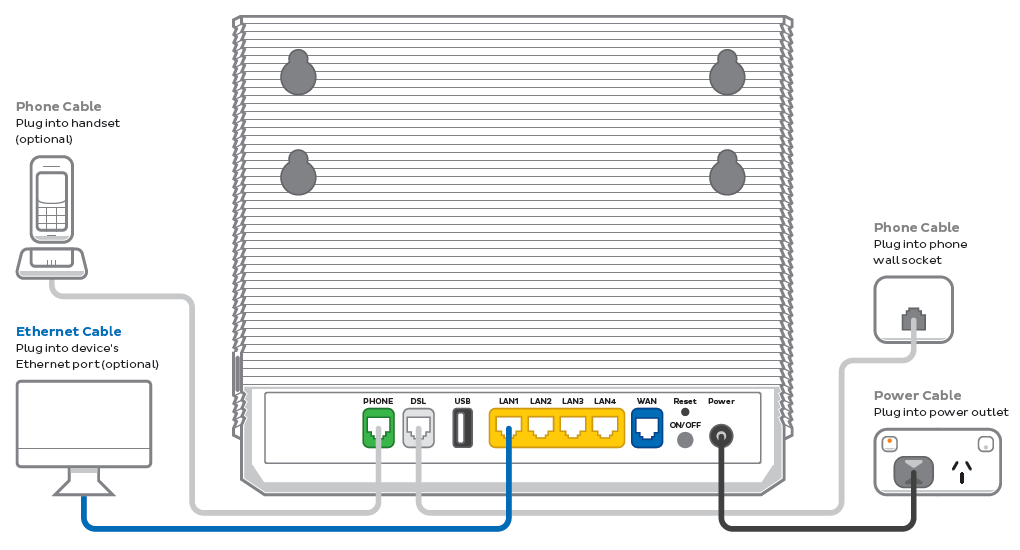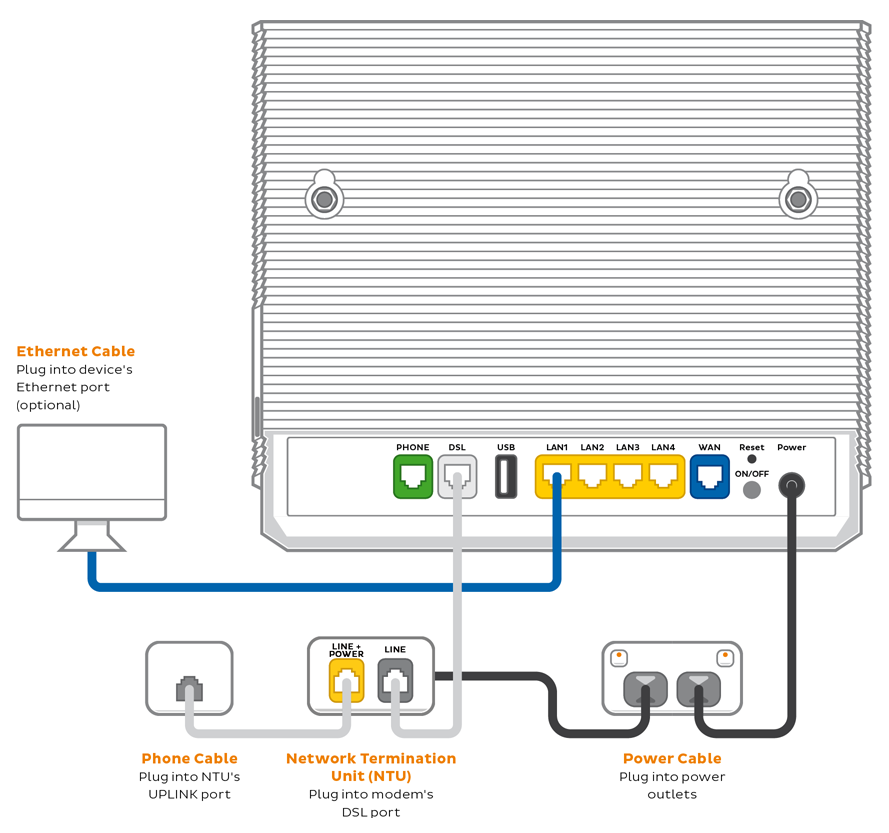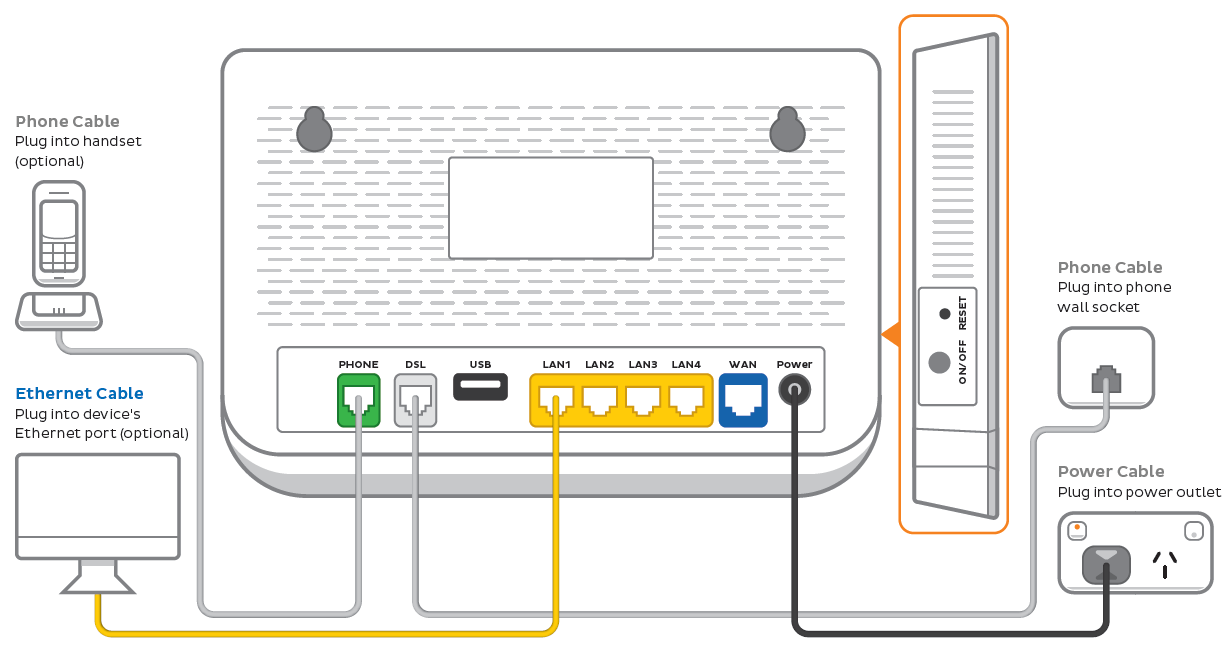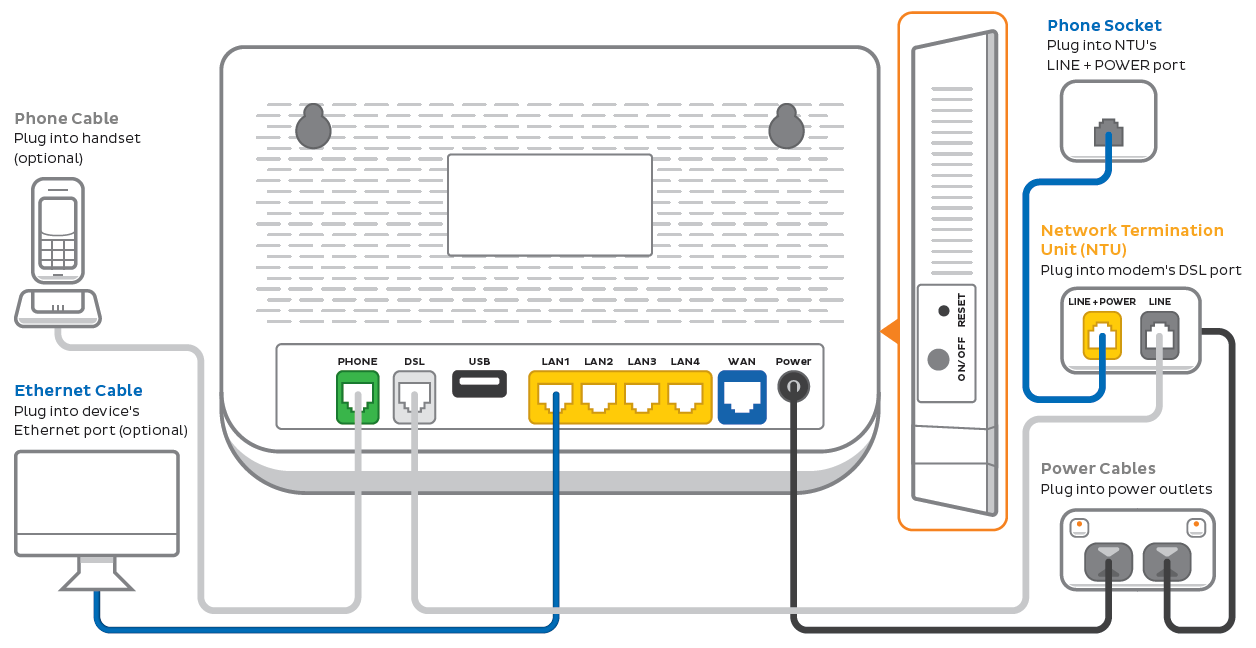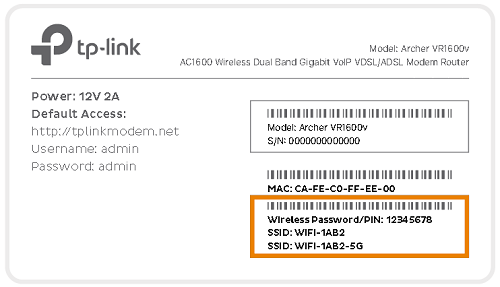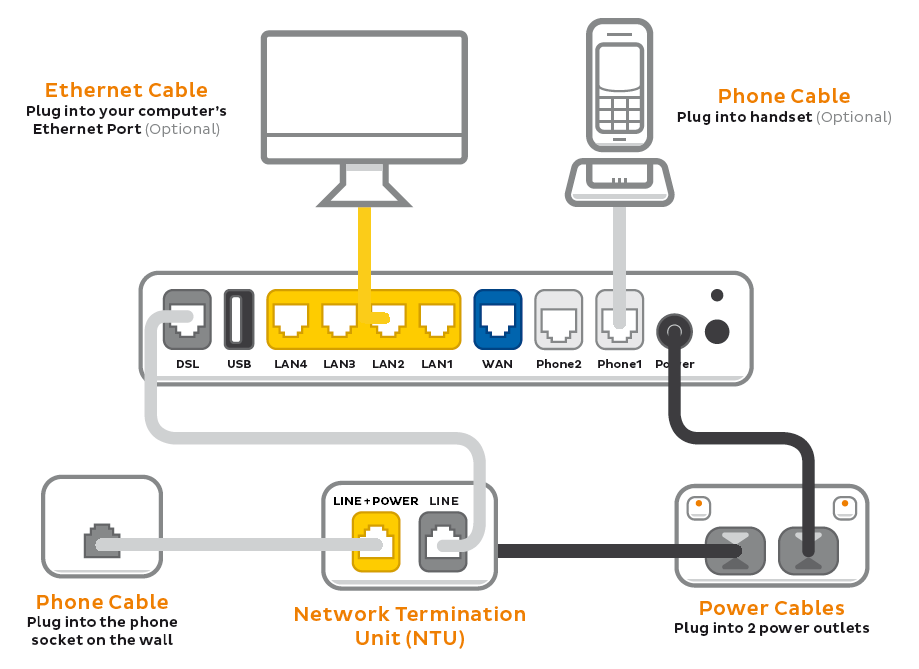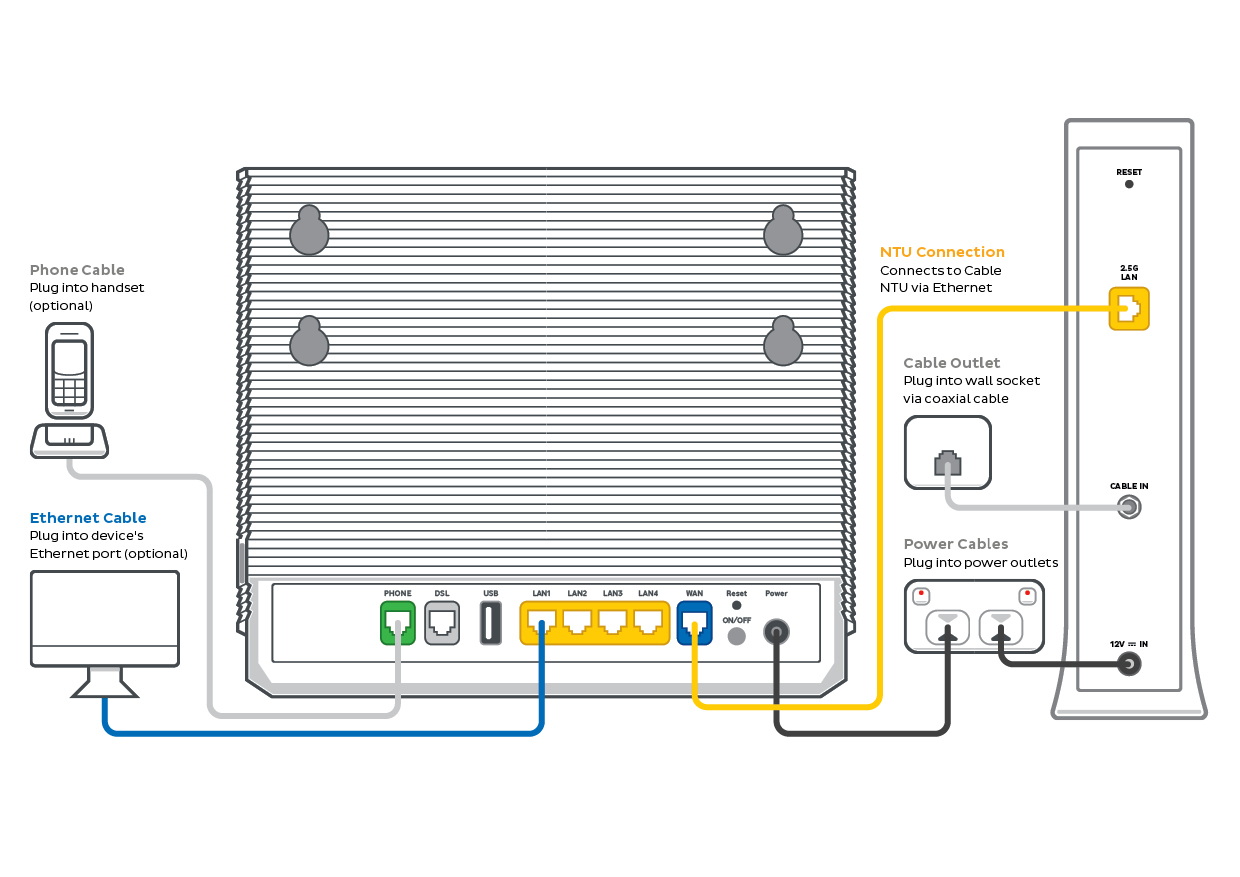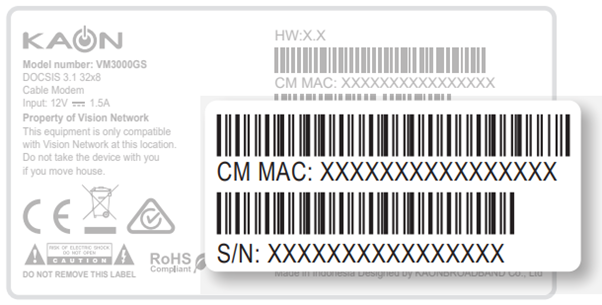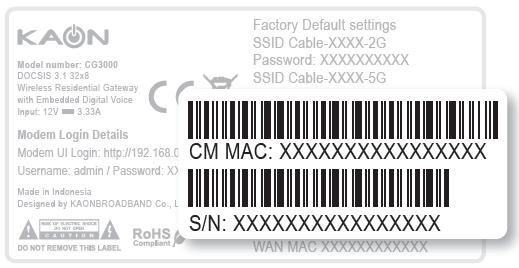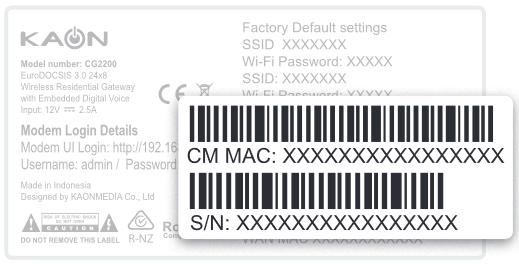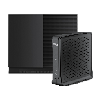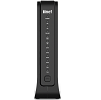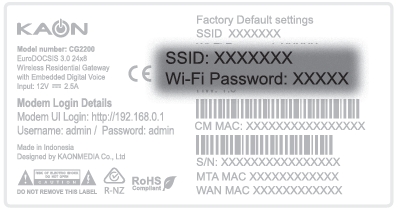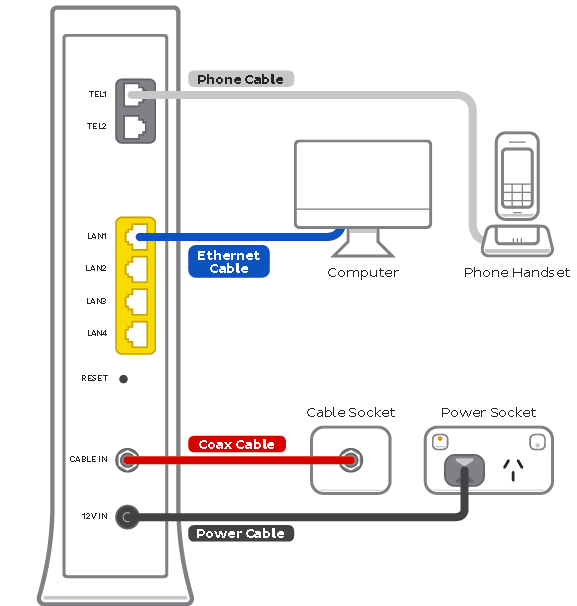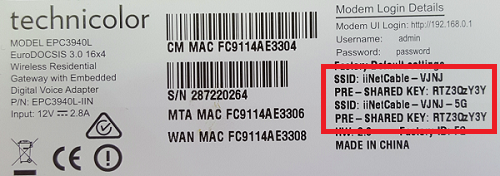If your Ultra Broadband FTTB service is having dropouts, it means your internet will go offline and come back online intermittently. These steps will help you identify the issue.
- Your service may just be affected by an outage or planned maintenance. You can check your address on our Network Status page.
If there is an outage or planned maintenance, the results will give you an estimated fix time. - Do you have any devices connected to your modem with an Ethernet cable? If these devices stay connected when devices on Wi-Fi drop out, switch to troubleshooting WiFi Dropouts.
- Find your modem and make sure the cables are plugged in securely and not damaged. Our setup guide will show you how to plug in.
You’ll need to replace any broken or chewed cables. Not all setups have a Network Termination Unit (NTU). - If you have a Network Termination Unit (NTU) and you notice any of these status light behaviours, please call us on 13 22 58.
ZyXel GM4100-B0 G.Fast NTU - Slow blinking green G.Fast light
The phone cable must not be longer than 1 metre.
Adtran® 422G Gfast NTU - Flashing green G.Fast light
The phone cable must not be longer than 1 metre.
LEA Networks NTU - Flashing green OUT or Warning light
Power/DIAG NTU - Red DIAG light - Still getting dropouts? Please call us on 13 22 58 and we’ll help you.
If your Ultra Broadband FTTB service is offline, you won’t be able to visit a website, browse, stream, or download. Email and any other services that use the internet will not work. These steps will help you identify the issue.
- Your service may just be affected by an outage or planned maintenance. You can check your address on our Network Status page.
If there is an outage or planned maintenance, the results will give you an estimated fix time. - Find your modem and make sure the cables are plugged in securely and not damaged. Our setup guide will show you how to plug in.
You’ll need to replace any broken or chewed cables. Not all setups have a Network Termination Unit (NTU).
- Turn off the your modem's power outlet for at least 10 seconds.
- Turn the outlet back on and wait for your modem’s Internet light to come on, then see if you can visit a website.
- If you have a Network Termination Unit (NTU) and you notice any of these status light behaviours, please call us on 13 22 58.
ZyXel GM4100-B0 G.Fast NTU - Slow blinking green G.Fast light
The phone cable must not be longer than 1 metre.
Adtran® 422G G.Fast NTU - Flashing green G.Fast light
The phone cable must not be longer than 1 metre.
LEA Networks NTU - Flashing green OUT or Warning light
Power/DIAG NTU - Red DIAG light - Do you have any devices connected to your modem with an Ethernet cable? If these devices can visit a website but devices on Wi-Fi can’t, switch to troubleshooting Wi-Fi No Connection.
- If you can view websites on some devices but not others, even when they’re both connected the same way, you may need to fix some browser settings. Check out our guide on Browsing issues.
- Still can't get online? Please call us on 13 22 58 and we’ll help you.
If your Ultra Broadband FTTB service is running slowly, these steps will help you identify the issue.
-
Your service may just be affected by planned maintenance. You can check your address on our Network Status page.
If there is planned maintenance, the results will give you an estimated fix time. -
Find your modem and turn off its power outlet for at least 10 seconds.
-
Turn the outlet back on and wait for your modem’s Internet light to come on, then run a speed test.
- Do you have any devices connected to your modem with an Ethernet cable? If speeds on these devices are fine but devices on WiFi are slow, switch to Troubleshooting WiFi speed.
-
Make sure that the device you’re using to run speeds tests is the only one connected to your modem. Unplug all other devices from your modem’s Ethernet ports and turn off other devices that are connected to the Wi-Fi.
-
On your one device, close all other apps using the internet, then run a speed test.
-
If your speed has improved on a single device, you may be running more devices or apps than your connection can handle at the same time. Some apps run in the background - you should close them if you don't need them.
- If you use Windows, you can press CTRL+ALT+DELETE on your keyboard and then open the Task Manager to see what's running.
- If you have a Mac, you can see all the apps running in the Dock at the bottom of the screen. -
Make sure your modem’s Ethernet cables are in good condition, with “CAT6” or “CAT5e” printed on them.
Older Cat5 Ethernet cables are not recommended for nbn services. You’ll need to replace any broken or chewed cables.
-
Run a scan on your antivirus/anti-malware software. If your software includes any firewalls, temporarily disable them and run a speed test to see if they’re slowing down your internet.
If any infections are detected, make sure they are quarantined and removed. Contact your software’s Customer Support if you need help.
-
Still getting slow speeds? Please call us on 13 22 58 and we’ll help you.
Your modem will take care of the hard stuff like internet settings, but we’ll need your help to plug it in. The main cables you need will come in the box, and you can grab extra Ethernet cables from the shops if you need them.
Note: Some homes will have a Network Termination Unit (NTU). If your place has never been connected to FTTB before, an NTU will be delivered with your modem if you need one.
Choose your modem (with or without NTU) to get started:
Wi-Fi Max Modem
- Wait for a message from us asking you to plug in your modem. We need to get your connection ready on our side first.
- Find your phone wall socket – you may already have a modem plugged in from your last internet service. Unplug any old modem from the phone wall socket and power outlet.
- Use the power cable to connect your modem's Power port to a power outlet.
- Use the phone cable to connect your modem’s grey DSL port to your phone wall socket.
- Turn on the power outlet and press your modem’s ON/OFF button.
- To use your FTTB phone service, just plug a handset into your modem’s grey Phone port.
- Leave your modem alone for 20 minutes while it runs through its automatic setup.
- Check the light on the front of your modem. If it’s green, you’re online and you can start connecting your devices.
No green light? Call us on 1300 997 274 and we can help you out. - It’s easy to set up your home network by downloading the My Internet Connect App (Android / iOS). To connect your devices to Wi-Fi, you have these options:
- Use the default Wi-Fi name and Wi-Fi Password on your modem's barcode sticker.
- Use a smartphone to scan the QR code on your modem’s barcode sticker.
- Enable Wi-Fi Protected Setup (WPS) on your device then press the Pair button on the back of your modem for 3 seconds.
If you want to change your Wi-Fi name or password, see this guide.
- For online gaming or HD/4K streaming, Ethernet is better than Wi-Fi. If you have extra Ethernet cables, you can connect up to 2 devices to your modem’s yellow LAN ports.
- You’re now good to go.
If you don’t want to keep your old modem, see if your local council has any eWaste recycling facilities.
Wi-Fi Max Modem with a Network Termination Unit (NTU)
- Wait for a message from us asking you to plug in your modem. We need to get your connection ready on our side first.
- Find your phone wall socket – you may already have a modem plugged in from your last internet service. Unplug any old modem from the phone wall socket and power outlet
- Use the power cables to connect the Power ports on your modem and NTU to power outlets.
- If your NTU has G.Fast and LAN ports: Use an Ethernet cable to connect your modem’s red WAN port to your NTU's LAN port.
If your NTU has a LINE + POWER and LINE ports: Use a phone cable to connect your modem’s grey DSL port to your NTU's LINE port.
Older NTUs may have a MODEM port that plugs into your modem’s DSL port. Learn more. - Use a phone cable to connect your your NTU's LINE + POWER or G.Fast port to your phone wall socket.
Older NTUs may have an UPLINK port. Learn more. - Turn on both power outlets and press your modem’s ON/OFF button.
- To use your FTTB phone service, just plug a handset into your modem’s grey Phone port.
- Leave your modem alone for 20 minutes while it runs through its automatic setup.
- Check the light on the front of your modem. If it’s green, you’re online and you can start connecting your devices.
No green light? Call us on 1300 997 274 and we can help you out. - It’s easy to set up your home network by downloading the My Internet Connect App (Android / iOS). To connect your devices to Wi-Fi, you have these options:
- Use the default Wi-Fi name and Wi-Fi Password on your modem's barcode sticker.
- Use a smartphone to scan the QR code on your modem’s barcode sticker.
- Enable Wi-Fi Protected Setup (WPS) on your device then press the Pair button on the back of your modem for 3 seconds.
If you want to change your Wi-Fi name or password, see this guide.
- For online gaming or HD/4K streaming, Ethernet is better than Wi-Fi. If you have extra Ethernet cables, you can connect up to 2 devices to your modem’s yellow LAN ports.
- You’re now good to go.
If you don’t want to keep your old modem, see if your local council has any eWaste recycling facilities.
VX420-G2V Modem
- First, make sure you’ve got a message from us asking you to plug in your modem. We need to get your connection ready on our side first.
- Find your phone wall socket – you probably already have a modem plugged in from your last internet service. Unplug any old modem from the phone wall socket and power outlet.
- Use the power cable to connect your modem's Power port to a power outlet.
- Use the phone cable to connect your modem’s grey DSL port to your phone wall socket.
- Turn on the power outlet and press your modem’s ON/OFF button.
- Leave your modem alone for 30 minutes while it runs through its automatic setup.
- Check the Internet light on your modem. If it’s green, you’re online and you can start connecting your devices.
No green light? Call us on 13 22 58 and we can help you out. - You'll find the default Wi-Fi name (SSID) and Wireless password/PIN on your modem's barcode sticker. If you want to change your Wi-Fi name or password, use this guide.
- Your devices will automatically connect to the best Wi-Fi possible. If your Wi-Fi’s running slow, check out Improving Wi-Fi Signal.
- For online gaming or HD/4K streaming, Ethernet is better than Wi-Fi. If you have extra Ethernet cables, you can connect up to 4 devices to your modem’s yellow LAN ports.
- To use your FTTB Phone service, just plug a handset into your modem’s green Phone port.
- You’re now good to go.
If you don’t want to keep your old modem, see if your local council has any eWaste recycling facilities.
VX420-G2V Modem with a Network Termination Unit (NTU)
- First, make sure you’ve got a message from us asking you to plug in your modem. We need to get your connection ready on our side first.
- Find your phone wall socket – you probably already have a modem plugged in from your last internet service. Unplug any old modem from the phone wall socket and power outlet.
- Use the power cables to connect the Power port on your modem and NTU to power outlets.
- If your NTU has a G.Fast port: Use an Ethernet cable to connect your modem’s blue WAN port to your NTU's LAN 1 port.
Older NTUs may have a LAN port instead. Learn more.
If your NTU doesn't have a G.Fast port: Use a phone cable to connect your modem’s grey DSL port to your NTU's LINE port.
Older NTUs may have a MODEM port instead. Learn more. - Use a phone cable to connect your your NTU's LINE + POWER or G.Fast port to your phone wall socket.
Older NTUs may have an UPLINK port instead. Learn more. - Turn on the power outlet and press your modem’s ON/OFF button.
- Leave your modem alone for 30 minutes while it runs through its automatic setup.
- Check the Internet light on your modem. If it’s green, you’re online and you can start connecting your devices.
No green light? Call us on 13 22 58 and we can help you out. - You'll find the default Wi-Fi name (SSID) and Wireless password/PIN on your modem's barcode sticker. If you want to change your Wi-Fi name or password, use this guide.
- Your devices will automatically connect to the best Wi-Fi possible. If your Wi-Fi’s running slow, check out Improving Wi-Fi Signal.
- For online gaming or HD/4K streaming, Ethernet is better than Wi-Fi. If you have extra Ethernet cables, you can connect up to 4 devices to your modem’s yellow LAN ports.
- To use your FTTB Phone service, just plug a handset into your modem’s green Phone port.
- You’re now good to go.
If you don’t want to keep your old modem, see if your local council has any eWaste recycling facilities.
Smart Modem Gateway (VX420-G2H)
Please note: If you choose to re-use your Smart Modem Gateway for Ultra FTTB, your FTTB Phone VoIP service will not work.
- First, make sure you’ve got a message from us asking you to plug in your modem. We need to get your connection ready on our side first.
- Find your phone wall socket – you probably already have a modem plugged in from your last internet service. Unplug any old modem from the phone wall socket and power outlet.
- Use the power cable to connect your modem's Power port to a power outlet.
- Use the phone cable to connect your modem’s grey DSL port to your phone wall socket.
- Turn on the power outlet and press your modem’s ON/OFF button.
- Leave your modem alone for 30 minutes while it runs through its automatic setup.
- Check the Internet light on your modem. If it’s green, you’re online and you can start connecting your devices.
No green light? Call us on 13 22 58 and we can help you out. - You'll find the default Wi-Fi name (SSID) and Wireless password/PIN on your modem's barcode sticker. If you want to change your Wi-Fi name or password, use this guide.
- Your devices will automatically connect to the best Wi-Fi possible. If your Wi-Fi’s running slow, check out Improving Wi-Fi Signal.
- For online gaming or HD/4K streaming, Ethernet is better than Wi-Fi. If you have extra Ethernet cables, you can connect up to 4 devices to your modem’s yellow LAN ports.
- You’re now good to go.
If you don’t want to keep your old modem, see if your local council has any eWaste recycling facilities.
Smart Modem Gateway (VX420-G2H) with a Network Termination Unit (NTU)
Please note: If you choose to re-use your Smart Modem Gateway for Ultra FTTB, your FTTB Phone VoIP service will not work.
- First, make sure you’ve got a message from us asking you to plug in your modem. We need to get your connection ready on our side first.
- Find your phone wall socket – you probably already have a modem plugged in from your last internet service. Unplug any old modem from the phone wall socket and power outlet.
- Use the power cables to connect the Power port on your modem and NTU to power outlets.
- If your NTU has a G.Fast port: Use an Ethernet cable to connect your modem’s blue WAN port to your NTU's LAN 1 port.
Older NTUs may have a LAN port instead. Learn more.
If your NTU doesn't have a G.Fast port: Use a phone cable to connect your modem’s grey DSL port to your NTU's LINE port.
Older NTUs may have a MODEM port instead. Learn more. - Use a phone cable to connect your your NTU's LINE + POWER or G.Fast port to your phone wall socket.
Older NTUs may have an UPLINK port instead. Learn more. - Turn on the power outlet and press your modem’s ON/OFF button.
- Leave your modem alone for 30 minutes while it runs through its automatic setup.
- Check the Internet light on your modem. If it’s green, you’re online and you can start connecting your devices.
No green light? Call us on 13 22 58 and we can help you out. - You'll find the default Wi-Fi name (SSID) and Wireless password/PIN on your modem's barcode sticker. If you want to change your Wi-Fi name or password, use this guide.
- Your devices will automatically connect to the best Wi-Fi possible. If your Wi-Fi’s running slow, check out Improving Wi-Fi Signal.
- For online gaming or HD/4K streaming, Ethernet is better than Wi-Fi. If you have extra Ethernet cables, you can connect up to 4 devices to your modem’s yellow LAN ports.
- You’re now good to go.
If you don’t want to keep your old modem, see if your local council has any eWaste recycling facilities.
VX220-G2V Modem
- First, make sure you’ve got a message from us asking you to plug in your modem. We need to get your connection ready on our side first.
- Find your phone wall socket – you probably already have a modem plugged in from your last internet service. Unplug any old modem from the phone wall socket and power outlet.
- Use the power cable to connect your modem's Power port to a power outlet.
- Use the phone cable to connect your modem’s grey DSL port to your phone wall socket.
- Turn on the power outlet and press your modem’s ON/OFF button.
- Leave your modem alone for 30 minutes while it runs through its automatic setup.
- Check the Internet light on your modem. If it’s blue, you’re online and you can start connecting your devices.
No blue light? Call us on 13 22 58 and we can help you out. - You'll find the default Wi-Fi name (SSID) and Password on your modem's barcode sticker. If you want to change your Wi-Fi name or password, use this guide.
- Your devices will automatically connect to the best Wi-Fi possible. If your Wi-Fi’s running slow, check out Improving Wi-Fi Signal.
- For online gaming or HD/4K streaming, Ethernet is better than Wi-Fi. If you have extra Ethernet cables, you can connect up to 4 devices to your modem’s yellow LAN ports.
- To use your FTTB Phone service, just plug a handset into your modem’s green Phone port.
- You’re now good to go.
If you don’t want to keep your old modem, see if your local council has any eWaste recycling facilities.
VX220-G2V Modem with a Network Termination Unit (NTU)
- First, make sure you’ve got a message from us asking you to plug in your modem. We need to get your connection ready on our side first.
- Find your phone wall socket – you probably already have a modem plugged in from your last internet service. Unplug any old modem from the phone wall socket and power outlet.
- Use the power cables to connect the Power port on your modem and NTU to power outlets.
- If your NTU has a G.Fast port: Use an Ethernet cable to connect your modem’s blue WAN port to your NTU's LAN 1 port.
Older NTUs may have a LAN port instead. Learn more.
If your NTU doesn't have a G.Fast port: Use a phone cable to connect your modem’s grey DSL port to your NTU's LINE port.
Older NTUs may have a MODEM port instead. Learn more. - Use a phone cable to connect your your NTU's LINE + POWER or G.Fast port to your phone wall socket.
Older NTUs may have an UPLINK port instead. Learn more. - Turn on the power outlet and press your modem’s ON/OFF button.
- Leave your modem alone for 30 minutes while it runs through its automatic setup.
- Check the Internet light on your modem. If it’s blue, you’re online and you can start connecting your devices.
No blue light? Call us on 13 22 58 and we can help you out. - You'll find the default Wi-Fi name (SSID) and Password on your modem's barcode sticker. If you want to change your Wi-Fi name or password, use this guide.
- Your devices will automatically connect to the best Wi-Fi possible. If your Wi-Fi’s running slow, check out Improving Wi-Fi Signal.
- For online gaming or HD/4K streaming, Ethernet is better than Wi-Fi. If you have extra Ethernet cables, you can connect up to 4 devices to your modem’s yellow LAN ports.
- To use your FTTB Phone service, just plug a handset into your modem’s green Phone port.
- You’re now good to go.
If you don’t want to keep your old modem, see if your local council has any eWaste recycling facilities.
TP-Link VR1600v
- First, make sure you’ve got a message from us asking you to plug in your modem. We need to get your connection ready on our side first.
- Find your phone wall socket – you probably already have a modem plugged in from your last internet service. Unplug any old modem from the phone wall socket and power outlet.
- Use the power cable to connect your modem's Power port to a power outlet.
- Use the phone cable to connect your modem’s grey DSL port to your phone wall socket.
- Turn on the power outlet and press your modem’s Power button.
- Leave your modem alone for 30 minutes while it runs through its automatic setup.
- Check the Internet light on your modem. If it’s green, you’re online and you can start connecting your devices.
No green light? Call us on 13 22 58 and we can help you out. - You'll find the default Wi-Fi name (SSID) and Wireless password/PIN on your modem's barcode sticker. If you want to change your Wi-Fi name or password, use this guide.
Your devices will automatically connect to the best Wi-Fi possible. If your Wi-Fi’s running slow, check out Improving Wi-Fi Signal. - For online gaming or HD/4K streaming, Ethernet is better than Wi-Fi. If you have extra Ethernet cables, you can connect up to 4 devices to your modem’s yellow LAN ports.
- To use your FTTB Phone service, just plug a handset into your modem’s grey Phone1 port.
- You’re now good to go.
If you don’t want to keep your old modem, see if your local council has any eWaste recycling facilities.
TP-Link VR1600v with a Network Termination Unit (NTU)
- First, make sure you’ve got a message from us asking you to plug in your modem. We need to get your connection ready on our side first.
- Find your phone wall socket – you probably already have a modem plugged in from your last internet service. Unplug any old modem from the phone wall socket and power outlet.
- Use the power cables to connect the Power port on your modem and NTU to power outlets.
- If your NTU has a G.Fast port: Use an Ethernet cable to connect your modem’s blue WAN port to your NTU's LAN 1 port.
Older NTUs may have a LAN port instead. Learn more.
If your NTU doesn't have a G.Fast port: Use a phone cable to connect your modem’s grey DSL port to your NTU's LINE port.
Older NTUs may have a MODEM port instead. Learn more. - Use a phone cable to connect your your NTU's LINE + POWER or G.Fast port to your phone wall socket.
Older NTUs may have an UPLINK port instead. Learn more. - Turn on the power outlet and press your modem’s ON/OFF button.
- Leave your modem alone for 30 minutes while it runs through its automatic setup.
- Check the Internet light on your modem. If it’s green, you’re online and you can start connecting your devices.
No green light? Call us on 13 22 58 and we can help you out. - You'll find the default Wi-Fi name (SSID) and Wireless password/PIN on your modem's barcode sticker. If you want to change your Wi-Fi name or password, use this guide.
- Your devices will automatically connect to the best Wi-Fi possible. If your Wi-Fi’s running slow, check out Improving Wi-Fi Signal.
- For online gaming or HD/4K streaming, Ethernet is better than Wi-Fi. If you have extra Ethernet cables, you can connect up to 4 devices to your modem’s yellow LAN ports.
- To use your FTTB Phone service, just plug a handset into your modem’s grey Phone1 port.
- You’re now good to go.
If you don’t want to keep your old modem, see if your local council has any eWaste recycling facilities.
Here's everything you need to know about iiNet Ultra Broadband Cable.
Select one of the links below to jump to a query:
- Where is Ultra Broadband Cable available?
- What do I need for Ultra Broadband Cable?
- Will Ultra Broadband Cable be replaced by the nbn®?
- What happens when Ultra Broadband Cable is installed?
Where is Ultra Broadband Cable available?
The iiNet Ultra Broadband Cable network is available in select areas across Geelong, Mildura, and Ballarat. The easiest way to confirm availability is to check your address on our website.
What do I need for Ultra Broadband Cable?
- Cable NTU
The Network Termination Unit (NTU) is a connection box that’s delivered by the Cable installer. These are required for all Cable connections from 14 May 2025 onwards.
- Cable modem
We include a Wi-Fi Cable modem with every Cable order – once it arrives from our warehouse, you can plug it in into the NTU.
- Phone
To use your Netphone VoIP service, you'll need a phone to plug into your Cable modem.
Will Ultra Broadband Cable be replaced by the nbn®?
iiNet Ultra Broadband Cable will not be affected by the nbn rollout. It is a future-ready network that delivers a high performance alternative to the nbn.
If you are an existing Cable customer, please ignore any nbn notifications that you may receive telling you that your broadband will be disconnected as part of the nbn rollout. You don’t have to switch to the nbn.
What happens when Ultra Broadband Cable is installed?
If a Cable installer is required to visit your premises, we'll be in touch to book a suitable appointment with you. The installer will complete your connection and run a test to make sure you can get online.
Note: If your iiNet Cable modem hasn't been delivered before your Cable installation, don't worry. The technician will use their own modem to test the connection, and you can plug in your iiNet Cable modem once it's delivered.
If your Ultra Broadband Cable service is having dropouts, it means your internet will go offline and come back online intermittently. These steps will help you identify the issue.
- Your service may just be affected by an outage or planned maintenance. You can check your address on our Network Status page.
If there is an outage or planned maintenance, the results will give you an estimated fix time. -
Do you have any devices connected to your modem with an Ethernet cable? If these devices stay connected when devices on Wi-Fi drop out, switch to troubleshooting Wi-Fi Dropouts.
-
Find your Cable modem and make sure the cables are plugged in securely and not damaged. Our setup guide will show you how to plug in.
You’ll need to replace any broken or chewed cables.
-
Still getting dropouts? Please call us on 13 22 58 and we’ll help you.
If your Ultra Broadband Cable service is offline, you won’t be able to visit a website, browse, stream, or download. Email and any other services that use the internet will not work. These steps will help you identify the issue.
- Your service may just be affected by an outage or planned maintenance. You can check your address on our Network Status page.
If there is an outage or planned maintenance, the results will give you an estimated fix time. -
Find your Cable modem and make sure the cables are plugged in securely and not damaged. Our setup guide will show you how to plug in.
You’ll need to replace any broken or chewed cables.
-
Turn off your modem’s power outlet for at least 10 seconds.
-
Turn the outlet back on and wait for your modem’s Internet light to come on, then see if you can visit a website.
Do you have any devices connected to your modem with an Ethernet cable? If these devices can visit a website but devices on Wi-Fi can’t, switch to troubleshooting Wi-Fi No Connection.
- If you can view websites on some devices but not others, even when they’re both connected the same way, you may need to fix some browser settings. Check out our guide on Browsing issues.
- Still can't get online? Please call us on 13 22 58 and we’ll help you. To investigate your connection issue, we'll need the Serial Number (S/N) and CMAC Number for your Cable NTU or modem barcode sticker:
Example: VM3000GS NTU
Example: CG3000 Modem
Example: CG2200 Modem
Example: EPC3940L Modem
If your Ultra Broadband Cable service is running slowly, these steps will help you identify the issue.
- Your service may just be affected by planned maintenance. You can check your address on our Network Status page.
If there is planned maintenance, the results will give you an estimated fix time. - Find your Cable modem and turn off its power outlet for at least 10 seconds.
-
Turn the outlet back on and wait for your modem’s Internet light to come on, then run a speed test.
-
Do you have any devices connected to your modem with an Ethernet cable? If speeds on these devices are fine but devices on Wi-Fi are slow, switch to Troubleshooting Wi-Fi speed.
-
Make sure that the device you’re using to run speeds tests is the only one connected to your modem. Unplug all other devices from your modem’s Ethernet ports and turn off other devices that are connected to the Wi-Fi.
-
On your one device, close all other apps using the internet, then run a speed test.
-
If your speed has improved on a single device, you may need to upgrade your Cable plan to get enough bandwidth to support more apps or devices.
You can change your plan in Toolbox or call us on 13 19 17.
-
Make sure your modem’s Ethernet cables are in good condition, with “CAT6” or “CAT5e” printed on them.
Older Cat5 Ethernet cables are not recommended for Cable services. You’ll need to replace any broken or chewed cables.
-
Run a scan on your antivirus/anti-malware software. If your software includes any firewalls, temporarily disable them and run a speed test to see if they’re slowing down your internet.
If any infections are detected, make sure they are quarantined and removed. Contact your software’s Customer Support if you need help.
-
Still getting slow speeds? Please call us on 13 22 58 and we’ll help you.
Your modem will take care of the hard stuff like internet settings, but we’ll need your help to plug it in. The main cables you need will come in the box, and you can grab extra Ethernet cables from the shops if you need them.
Not sure which model you have? Please check your modem's barcode sticker on the base.
Choose your modem to get started:
| Picture | Modem |
|---|---|
| Wi-Fi Max Modem with NTU | |
| Cable Gateway Pro (CG3000) | |
Wi-Fi Max Modem with NTU
- Your Cable Network Termination Unit (NTU) should already be connected by the Cable installer. If not, wait until your Cable installation is complete.
- Use the Ethernet cable to connect your modem’s red 2.5G WAN port to the NTU’s 2.5G LAN port.
- To use your Cable phone service, just plug a handset into your modem’s grey Phone port.
- Leave your modem alone for 20 minutes while it runs through its automatic setup.
- Check the light on the front of your modem. If it’s green, you’re online and you can start connecting your devices.
No green light? Call us on 1300 997 274 and we can help you out. - It’s easy to set up your home network by downloading the My Internet Connect App (Android / iOS). To connect your devices to Wi-Fi, you have these options:
- Use the default Wi-Fi name and Wi-Fi Password on your modem's barcode sticker.
- Use a smartphone to scan the QR code on your modem’s barcode sticker.
- Enable Wi-Fi Protected Setup (WPS) on your device then press the Pair button on the back of your modem for 3 seconds.
If you want to change your Wi-Fi name or password, see this guide.
- For online gaming or HD/4K streaming, Ethernet is better than Wi-Fi. If you have extra Ethernet cables, you can connect up to 2 devices to your modem’s yellow LAN ports.
- You’re now good to go.
If you don’t want to keep your old modem, see if your local council has any eWaste recycling facilities.
VX420-G2V Modem with NTU
- Your Cable Network Termination Unit (NTU) should already be connected by your Cable installer. If not, wait until your Cable installation is complete.
- Use the Ethernet cable to connect your modem’s blue WAN port to the NTU’s 2.5G LAN port.
- Use the power cable to connect your modem's 12V IN Port to a power outlet and press your modem’s ON/OFF button.
- Wait 20 minutes for your modem to connect automatically.
- Check the Internet light on your modem. If it’s green, you’re online and you can start connecting your devices.
No green light? Call us on 13 22 58 and we can help you out. - The default WiFi name (SSID) and Wireless password/PIN is on your modem’s barcode sticker. If you want to change your Wi-Fi name or password, use this guide.
- Your devices will automatically connect to the best Wi-Fi possible. If your Wi-Fi’s running slow, check out Improving Wi-Fi Signal.
- For online gaming or HD/4K streaming, Ethernet is better than Wi-Fi. If you have extra Ethernet cables, you can connect up to 4 devices to your modem’s yellow LAN ports.
- If you want to use your Cable Phone service, plug a VoIP-compatible handset into your modem’s green Phone port.
- You’re now good to go.
If you don’t want to keep your old modem, see if your local council has any eWaste recycling facilities.
Cable Gateway Pro (CG3000)
- First, make sure you’ve got a message from us asking you to plug in your modem. We need to get your connection ready on our side first.
- Connect the power cables from your modem's 12V IN Port to an electrical outlet.
- Connect the included RF coaxial cable from the CABLE IN connector on your modem to your cable wall outlet.
Important: Make sure the cable is connected securely at both ends, as a lose connection can affect your internet performance. - Make sure the electrical outlet for your modem is ON.
- Allow 15 minutes for your modem to boot up and connect automatically.
- Check the lights on your modem. If the Online light is green, you can start connecting your devices and get online.
- The default WiFi name (SSID) and password is on your modem’s barcode sticker. If you want to change your Wi-Fi name or password, use this guide.
- Your devices will automatically connect to the best Wi-Fi possible. If your Wi-Fi’s running slow, check out Improving Wi-Fi Signal.
- For online gaming or HD/4K streaming, Ethernet is better than Wi-Fi. If you have extra Ethernet cables, you can connect up to 4 devices to your modem’s yellow LAN ports.
- If you wish to use your Cable Phone service, plug a compatible handset into the TEL1 port on your modem.
- You’re now good to go.
If you don’t want to keep your old modem, see if your local council has any eWaste recycling facilities.
Cable Gateway Pro (CG2200)
- First, make sure you’ve got a message from us asking you to plug in your modem. We need to get your connection ready on our side first.
- Connect the power cables from your modem's 12V IN Port to an electrical outlet.
- Connect the included RF coaxial cable from the CABLE IN connector on your modem to your cable wall outlet.
Important: Make sure the cable is connected securely at both ends, as a lose connection can affect your internet performance. - Make sure the electrical outlet for your modem is ON.
- Allow 15 minutes for your modem to boot up and connect automatically.
- Check the lights on your modem. If the Online light is green, you can start connecting your devices and get online.
- The default WiFi name (SSID) and Wireless password/PIN is on your modem’s barcode sticker. If you want to change your Wi-Fi name or password, use this guide.
- Your devices will automatically connect to the best Wi-Fi possible. If your Wi-Fi’s running slow, check out Improving Wi-Fi Signal.
- For online gaming or HD/4K streaming, Ethernet is better than Wi-Fi. If you have extra Ethernet cables, you can connect up to 4 devices to your modem’s yellow LAN ports.
- If you wish to use your Cable Phone service, plug a compatible handset into the TEL1 port on your modem.
- You’re now good to go.
If you don’t want to keep your old modem, see if your local council has any eWaste recycling facilities.
Cable Gateway Pro (EPC3940L)
- First, make sure you’ve got a message from us asking you to plug in your modem. We need to get your connection ready on our side first.Connect the power cables from your modem's Power Port to an electrical outlet.
- Connect the included RF coaxial cable from the CABLE connector on your modem to your cable wall outlet.
Important: Make sure the cable is connected securely at both ends, as a lose connection can affect your internet performance. - Make sure the electrical outlet for your modem is ON.
- Allow 15 minutes for your modem to boot up and connect automatically.
- Check the lights on your modem. If the ONLINE light is green, you can start connecting your devices and get online.
- The default WiFi name (SSID) and password (Pre-Shared Key) is on your modem’s barcode sticker.
- Your devices will automatically connect to the best Wi-Fi possible. If your Wi-Fi’s running slow, check out Improving Wi-Fi Signal.
- For online gaming or HD/4K streaming, Ethernet is better than Wi-Fi. If you have extra Ethernet cables, you can connect up to 4 devices to your modem’s yellow LAN ports.
- If you wish to use your Cable Phone service, plug a compatible handset into the TELEPHONE 1 port on your modem.
- You’re now good to go.
If you don’t want to keep your old modem, see if your local council has any eWaste recycling facilities.
Here's everything you need to know about iiNet Ultra Broadband VDSL2.
Select one of the links below to jump to a query:
- Where is Ultra Broadband VDSL2 available?
- What do I need for an Ultra Broadband VDSL2 connection?
- What happens when Ultra Broadband VDSL2 is installed?
- Will my medical alarm, security alarm, EFTPOS machine or fax machine work on the VDSL2 network?
Where is Ultra Broadband VDSL2 available?
iiNet Ulta Broadband VDSL2 is only available in the ACT. You can check your address on our website.
What do I need for an Ultra Broadband VDSL2 connection?
We'll provide an iiNet modem. If you'd like to use the included VDSL2 Phone service to make calls over the internet, you'll need a VoIP-compatible phone to plug into your modem.
Some premises may also require a Network Termination Unit (NTU). If this is the case, we’ll supply this to you without charge. The NTU remains the property of iiNet and should not be removed from the premises once installed.
Note: You must use the iiNet modem to get online. You can connect your own Wi-Fi router to the iiNet modem if you want to.
What happens when Ultra Broadband VDSL2 is installed?
If a VDSL2 installer is required to visit your premises, we'll be in touch to book a suitable appointment with you. An installation may not be needed if VDSL2 has been connected at your address before.
A standard installation normally takes up to an hour, or two hours if you're getting an overhead cable connected to your property. The installer will complete your connection and run a test to make sure you can get online.
Note: If your iiNet modem hasn't been delivered before your installation, don't worry. The technician will use their own modem to test the connection, and you can plug in your iiNet modem once it's delivered.
Will my medical alarm, security alarm, EFTPOS machine or fax machine work on the VDSL2 network?
The following services may not work on VDSL2:
- Priority Assistance phone services
- Fax machines
- EFTPOS or vending machines
- Back-to-base VPN
- Monitored security alarms
- Dial-up security cameras
- Digital Pay TV
Please contact your service provider to make arrangements before you order VDSL2. It may be possible to switch to an alternative service that does work with VDSL2.
Please note: iiNet does not offer a Priority Assistance service. If you are a Priority Assistance customer, please consider this before you order.

